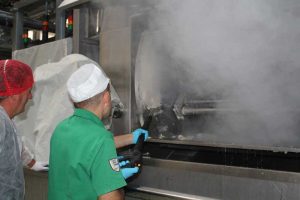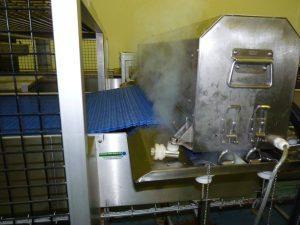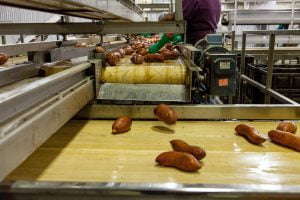Hygiene in food processing industries is of paramount importance as it directly affects the safety and quality of the food products being manufactured. Contaminated food can lead to severe health issues for consumers and may result in costly product recalls and damage to a company’s reputation. Therefore, maintaining high levels of hygiene throughout the food processing operation is crucial.
This includes ensuring that all equipment and machinery, including conveyor systems, are regularly cleaned and sanitised to prevent the spread of bacteria, pathogens and other contaminants. Failure to uphold proper hygiene standards can result in cross-contamination, spoilage and ultimately, a negative impact on the company’s financial performance. Moreover, with the increasing focus on food safety regulations and standards, it is imperative for food processing industries to adhere to strict hygiene protocols to ensure compliance and consumer trust.
Hygiene in food processing industries is not only important for the safety and quality of the products but also for the well-being of the workers. Proper hygiene practices can help prevent the spread of illnesses and diseases among employees, leading to a healthier and more productive workforce. It also demonstrates a company’s commitment to the well-being of its employees, which can have a positive impact on employee morale and retention.
Furthermore, maintaining high levels of hygiene can also reduce the risk of pest infestations, which can cause significant damage to both the products and the reputation of the company. Overall, prioritising hygiene in food processing industries is essential for protecting consumer health, upholding regulatory standards, ensuring employee well-being, and safeguarding the company’s reputation and financial stability.
Summary
- Hygiene is of utmost importance in food processing industries to ensure the safety and quality of the products.
- Contaminated conveyor systems pose a significant risk of foodborne illnesses and product recalls.
- Conveyor cleaning systems help to reduce the risk of contamination and improve overall hygiene in food processing facilities.
- There are various types of conveyor cleaning systems available, including dry cleaning, wet cleaning, and steam cleaning.
- Regular maintenance and cleaning of conveyor systems are essential best practices for maintaining hygiene and preventing contamination.
Risks of Contaminated Conveyor Systems
Risks of Cross-Contamination
If not properly cleaned and maintained, conveyor systems can become a source of cross-contamination, leading to the spread of harmful pathogens throughout the production line. This can result in costly product recalls, consumer illnesses, and damage to the company’s reputation.
Financial and Operational Impacts
Additionally, contaminated conveyor systems can also lead to product spoilage, as the presence of bacteria and mould can cause food products to deteriorate at a faster rate. This can result in financial losses for the company and negatively impact its bottom line.
Pest Infestations and Regulatory Consequences
Furthermore, contaminated conveyor systems can also attract pests such as rodents and insects, which can further exacerbate the risk of contamination. Pest infestations can not only cause damage to the products being transported but can also lead to regulatory violations and loss of consumer trust. In extreme cases, pest infestations can even result in production shutdowns and facility closures, causing significant disruption to the company’s operations. Therefore, it is crucial for food processing industries to be aware of the risks associated with contaminated conveyor systems and take proactive measures to prevent such issues from occurring.
Benefits of Conveyor Cleaning Systems

Implementing conveyor cleaning systems in food processing industries offers a wide range of benefits that directly contribute to the overall safety, quality, and efficiency of the production process. Firstly, regular cleaning and sanitization of conveyor systems help to prevent the build-up of bacteria, mould, and other contaminants that can compromise the integrity of the food products being transported. This helps to reduce the risk of cross-contamination and ensures that the products remain safe for consumption.
Additionally, clean conveyor systems also contribute to extending the shelf life of the products by reducing the risk of spoilage caused by microbial growth. Furthermore, conveyor cleaning systems can also improve operational efficiency by reducing downtime for maintenance and repairs. Clean conveyor systems are less prone to breakdowns and malfunctions, which can result in uninterrupted production schedules and higher output levels.
This ultimately leads to cost savings for the company by minimising production disruptions and maximising productivity. Moreover, implementing conveyor cleaning systems demonstrates a commitment to food safety and quality, which can enhance consumer trust and loyalty towards the brand. By prioritising hygiene and cleanliness, food processing industries can differentiate themselves in the market and gain a competitive edge.
Types of Conveyor Cleaning Systems
There are several types of conveyor cleaning systems available for food processing industries, each with its own unique features and benefits. One common type is mechanical conveyor cleaners, which utilise brushes or scrapers to physically remove debris and contaminants from the conveyor belt surface. These systems are effective at removing larger particles and residues but may require more frequent maintenance to ensure optimal performance.
Another type is steam cleaning systems, which use high-temperature steam to sanitise and disinfect conveyor belts. Steam cleaning is highly effective at killing bacteria and pathogens without the need for chemical detergents, making it an environmentally friendly option. Chemical cleaning systems are also widely used in food processing industries, employing detergents and sanitizers to remove stubborn residues and contaminants from conveyor belts.
These systems are effective at achieving a deep clean but require careful handling to ensure that no chemical residues remain on the belts after cleaning. Additionally, there are automated conveyor cleaning systems that are equipped with sensors and programmable controls to ensure consistent and thorough cleaning. These systems are ideal for large-scale operations where efficiency and precision are paramount.
Overall, selecting the right type of conveyor cleaning system depends on factors such as the nature of the contaminants, production volume, and specific hygiene requirements of the food processing facility.
Best Practices for Maintaining Conveyor Hygiene
Maintaining conveyor hygiene in food processing industries requires adherence to best practices that ensure thorough cleaning and sanitization while minimising the risk of contamination. Firstly, it is essential to establish a regular cleaning schedule based on production demands and hygiene standards. This includes daily cleaning routines as well as more comprehensive deep cleaning procedures at regular intervals.
It is also important to use appropriate cleaning agents that are safe for use in food processing environments and effective at removing specific types of contaminants. In addition, implementing proper training for employees responsible for conveyor cleaning is crucial to ensure that cleaning procedures are carried out correctly and consistently. This includes training on equipment operation, chemical handling, and safety protocols to minimise risks associated with cleaning activities.
Furthermore, conducting regular inspections of conveyor systems to identify any signs of wear or damage is essential for preventing potential contamination risks. Any worn or damaged components should be promptly repaired or replaced to maintain optimal hygiene standards. Lastly, documenting all cleaning activities and maintaining detailed records can provide valuable insights into the effectiveness of cleaning procedures and help identify areas for improvement.
Regulatory Standards for Conveyor Cleaning

Regulatory Requirements
Regulatory bodies such as the Food Standards Agency (FSA) in the UK and the Food and Drug Administration (FDA) in the US have established guidelines and requirements for maintaining hygiene in food processing facilities. These standards outline specific protocols for cleaning conveyor systems, including the use of approved cleaning agents, frequency of cleaning, and documentation of cleaning activities.
International Standards
In addition to national regulatory standards, many food processing industries also adhere to international standards such as Hazard Analysis Critical Control Points (HACCP) and ISO 22000, which provide comprehensive frameworks for ensuring food safety throughout the production process. These standards emphasise the importance of maintaining clean and sanitary conditions in food processing facilities, including conveyor systems.
Compliance and Consumer Trust
Compliance with regulatory standards is not only a legal requirement but also essential for gaining consumer trust and confidence in the safety and quality of the products.
Case Studies of Successful Implementation of Conveyor Cleaning Systems
Several food processing companies have successfully implemented conveyor cleaning systems to enhance hygiene standards and improve operational efficiency. One such example is a large-scale meat processing facility that invested in automated steam cleaning systems for its conveyor belts. By implementing these systems, the company was able to achieve consistent and thorough cleaning without the need for chemical detergents, reducing environmental impact while ensuring high levels of hygiene.
This resulted in a significant reduction in product recalls due to contamination issues and improved consumer confidence in the safety of their products. Another case study involves a bakery that utilised mechanical conveyor cleaners equipped with brushes to remove flour residues from its production lines. By incorporating these cleaning systems into their daily maintenance routines, the bakery was able to prevent cross-contamination between different product lines and maintain high levels of cleanliness throughout their facility.
This led to improved product quality and reduced waste due to spoilage, ultimately resulting in cost savings for the company. In conclusion, maintaining hygiene in food processing industries is essential for ensuring consumer safety, upholding regulatory standards, and protecting the reputation of companies. Contaminated conveyor systems pose significant risks that can lead to product recalls, financial losses, and damage to brand reputation.
Implementing effective conveyor cleaning systems offers numerous benefits such as improved product quality, operational efficiency, and consumer trust. By adhering to best practices for maintaining conveyor hygiene and complying with regulatory standards, food processing industries can mitigate contamination risks and demonstrate their commitment to producing safe and high-quality products. Case studies have shown that successful implementation of conveyor cleaning systems can lead to tangible improvements in hygiene standards and operational performance, making it a worthwhile investment for companies in the food processing industry.
FAQs
What are conveyor cleaning systems?
Conveyor cleaning systems are equipment designed to remove debris, contaminants, and buildup from conveyor belts and other food processing equipment.
Why are conveyor cleaning systems crucial for food processing industries?
Conveyor cleaning systems are crucial for food processing industries because they help maintain food safety and hygiene standards by preventing cross-contamination and the spread of bacteria and pathogens.
How do conveyor cleaning systems contribute to food safety?
Conveyor cleaning systems contribute to food safety by effectively removing food residues, allergens, and other contaminants from the equipment, reducing the risk of contamination in the production process.
What are the benefits of using conveyor cleaning systems in food processing?
The benefits of using conveyor cleaning systems in food processing include improved food safety, compliance with industry regulations, reduced risk of product recalls, and increased operational efficiency.
What types of conveyor cleaning systems are available for food processing industries?
There are various types of conveyor cleaning systems available, including brush cleaners, belt scrapers, steam cleaning systems, and dry ice blasting systems, each designed to address specific cleaning needs in food processing.
How often should conveyor cleaning systems be used in food processing facilities?
Conveyor cleaning systems should be used regularly as part of a comprehensive cleaning and sanitation schedule in food processing facilities, with the frequency depending on the specific requirements of the production process and the type of contaminants present.










